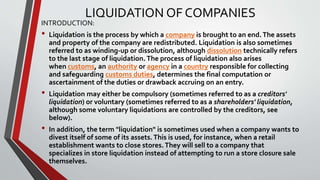About Company Liquidation
About Company Liquidation
Blog Article
Some Ideas on Company Liquidation You Should Know
Table of ContentsHow Company Liquidation can Save You Time, Stress, and Money.Examine This Report on Company LiquidationThe Best Strategy To Use For Company LiquidationGetting The Company Liquidation To WorkCompany Liquidation Fundamentals Explained
A liquidator is especially appointed to oversee the winding up of a company's affairs in order for it to be shut down normally when the firm is declaring bankruptcy. The liquidator is an impartial 3rd event that manages the sale of firm properties in order to settle any type of impressive financial obligations.Their function consists of, however is not limited to: Unbiased Overseer: A liquidator is tasked with acting as a neutral 3rd party to look after the entire business liquidation process. Produce Statement of Affairs: Liquidators have to develop a thorough statement of affairs document. This record is dispersed to lenders, detailing the existing economic condition of the company at the time of its liquidation.
After the liquidation of a company, its presence is eliminated from Companies Residence and it discontinues to be a legal entity. If supervisors browsed the process uncreative, there would be no penalties or individual obligation for strong financial debts expected. Currently, with a fresh start, supervisors can discover brand-new company opportunities, though specialist appointment is a good idea.
Company Liquidation - Questions
If more than 90% of all company shareholders concur, liquidation can take area on brief notification within seven days, the minimal statutory notification for financial institutions. Generally, the bigger the liquidation and the more assets and resources the business has, the longer the process will take.

We comprehend that no two firms are the same, which is why we will take the time to get to know your company so we can recommend the very best program of action for you. We only work in your benefits, so you can be entirely certain in the solution we give.
A Biased View of Company Liquidation
In the UK, there is an established process to folding or restructuring a minimal business, whether it is solvent or insolvent. This procedure is referred to as navigate to this site liquidation and can only be taken care of by a licensed bankruptcy specialist (IP) based on the Insolvency Act 1986. There are 4 primary kinds of company liquidation procedure: Creditors' Volunteer Liquidation (CVL); Mandatory liquidation; Management; and Members' Volunteer Liquidation (MVL).

In these circumstances, it is important that the firm stops trading; if the business proceeds to trade, the directors could be held personally responsible and it can lead to the insolvency expert reporting wrongful trading, referred to as misfeasance, which might lead to lawsuit. The supervisors designate a you could try here bankruptcy practitioner and as soon as this has been concurred and confirmed, there is a conference with the shareholders.
Obviously, if there are no shareholders, this action of the process is not needed (Company Liquidation). The IP takes control of the firm and starts the company liquidation process. The supervisors are no more involved in what happens, consisting of the sale of the company's possessions. Nonetheless, if the supervisors desire any of the assets, they can alert the IP.
Company Liquidation Fundamentals Explained
The main difference is that the firm's financial institutions put on the court for an ending up order which compels the bankrupt business into a liquidation process. Financial institutions take this activity as a last resort because they have not obtained repayment through various other types of negotiation. The court assigns an insolvency professional, also called a main receiver, to conduct the compulsory business liquidation process.
This sort of firm liquidation is not voluntary and supervisors' conduct is reported to the UK's Secretary of State once the liquidation procedure has actually been completed. Consequently, any kind of director that falls short to accept the IP or has been associated with director transgression, or an illegal act, may cause major effects (Company Liquidation).
It is used as a means to safeguard the business from any type of legal activity by its financial institutions. The directors of the business agree to make routine settlements to resolve their debts over a period of time.
6 Easy Facts About Company Liquidation Explained
This gives the firm with time to create a strategy moving forward to save the business and prevent liquidation. At this factor, supervisors hand control of the business over to the designated administrator. If a company is solvent yet the supervisors and investors desire to learn this here now close the company, a Members Volunteer Liquidation is the right choice.
The business liquidation process is managed by a liquidator appointed by the supervisors and shareholders of the company and they have to authorize a statement that there are no lenders remaining. The liquidation procedure for an MVL resembles that of a CVL in that assets are become aware yet the proceeds are dispersed to the supervisors and the investors of the business after the liquidator's charges have been paid.
Report this page